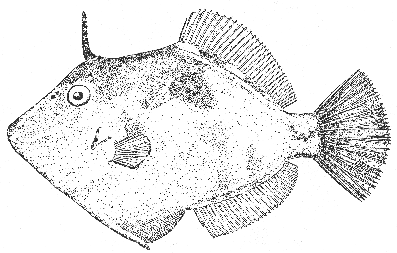Filefish Monacanthus hispidus (Linnaeus) 1766
[Jordan and Evermann, 1896-1900, p. 1715.]

Figure 276.—Filefish (Monacanthus hispidus). From Jordan and Evermann. Drawing by W. S. Haines.
Description—
In this species the rear edge of the dorsal spine, which is situated over the rear edge of the eye, is armed with a double series of barbs, but the sides of the rounded caudal peduncle do not bear any spines. The point of origin of the soft dorsal fin (32 to 34 rays) is behind the middle of the body, while the first soft dorsal ray often is much prolonged in adults and with a filamentous tip (young 1 to 2 inches long lack this filamentous ray.) Otherwise the fin is rounded in outline, narrowing from the front to the rear. The anal fin (31 to 34 rays) stands below the soft dorsal, and is of the same shape except that none of its rays are prolonged. The caudal fin is rounded. The pectorals are short, rounded, and situated lower than the gill openings, like those of triggerfishes.
Color—
Greenish, olive, or brownish. The back and sides of young fish are mottled with irregular darker blotches but adults are plain colored. The dorsal spine and the caudal fin are green. The soft dorsal fin and the anal fin are pale and translucent.
Size—
Maximum length about 10 inches.
General range—
This is a tropical species, common along the south Atlantic Coast of the United States and among the West Indies; also around the Canaries and Madeira in the eastern Atlantic, and represented in East Indian waters by a fish that does not seem to be distinguishable from it in any way. In the western side of the Atlantic it is known as far south as Brazil, has been taken from time to time as far north as Woods Hole, and has been recorded from St. Margaret Bay and from Halifax on the outer coast of Nova Seotia.[92]
[page 523]Occurrence in the Gulf of Maine—
Odd specimens of this filefish have been recorded from Hingham, Lynn, Nahant, and Boston Harbor in Massachusetts Bay; and from Cape Cod; all many years ago. More recent records of it in the Gulf are of 181 fry, 1-2 inches long, picked up from the Albatross II on the northeastern part of Georges Bank among floating Gulf weed (Sargassum), in September 1927; a larger one taken off Seguin Island, Maine, September 12, 1927;[93] one of 6 inches, at Provincetown, November 6, 1929; one picked up from the schooner Old Glory among floating rockweed (Fucus or Ascophyllum) and Gulf weed (Sargassum), on the western part of Georges Bank, September 15, 1930;[94] one taken off Portland Lightship, July 17, 1931; one taken in a trap at Provincetown, October 6, 1950; and two, about 6 inches long, taken off Wood End, Provincetown, in 17 fathoms, by the dragger Mary Magdalyn (Capt. Charles Santos), on October 30, 1951. It is also likely that a "filefish" taken at Beverly on the north shore of Massachusetts in 1933[95] was of this species. An occasional filefish straying from the south is thus to be expected anywhere on Georges Bank, or in the western side of the Gulf. But we find no evidence that they ever enter its eastern side, or that they ever reach the Bay of Fundy.
[92] The only recent Nova Scotian record that has come to our notice is of one taken in Halifax Harbor in the autumn of 1928 (Leim, Proc. Nova Scotian Inst. Sci., vol. 17, Pt. 4, 1930, p. 46).
[93] Kendall, Bull. 58, Boston Soc. Nat. Hist., 1931, p. 11.
[94] Firth, Bull. 61, Boston Soc. Nat. Hist., 1931, p. 13.
[95] MacCoy, Bull. 67, Boston Soc. Nat. Hist., 1933, p. 9.